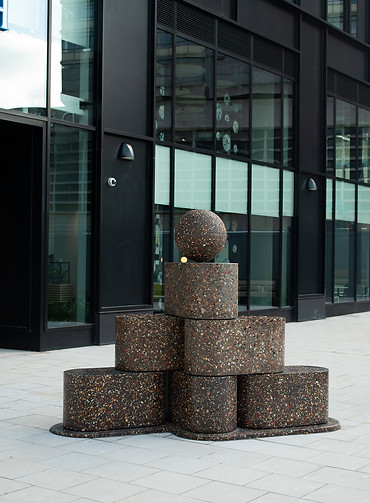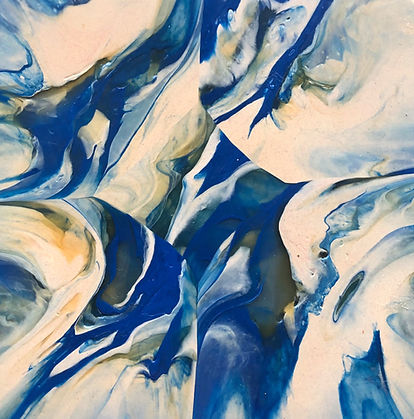


Waste-based Terrazzo Family
Charlotte Kidger b.1992
Commissioned by Gingko Projects for Zurich Insurance, 2022
Pre-cast concrete, recycled tv screens, quarry rejects, brick chipping, China clay stent, pigment rebar.
A Winner in the 2023 Wallpaper 'Best Elements of Surprise'' category.
This permanent collection of playfully brutalist figures explores the re-use and hidden beauty in overlooked and down-graded materials. The human-scaled sculptures offer an inviting and highly tactile encounter with material compilations that have been hand-crafted specifically for this commission. The selected materials are celebrated and championed for their beauty and end-of-life potential.










Last year I was commissioned by Ginkgo Art Projects and Zurich Insurance to design a permanent piece of Public Art for their new development in Swindon Town Centre. The brief was structured around Zurich’s 3 key pillars; Wellness, Community and Sustainability. Working closely with the Zurich Art Panel and Sophie Scott from Ginkgo Art Projects my aim was to deliver a series of playful human-scale sculptures, made from 3 different waste-based terrazzo’s. You’ll find this colourful, highly tactile family of sculptures in the landscaped area at the front of the building slightly disrupting the urban environment surrounding them. My aim was to use materials in interesting ways, create a sense of enjoyment and playfulness, encouraging people to take the time to dwell and overall inject character into the space.


After completing a material audit of the construction site last year to evaluate what materials could be salvaged or re-used it was quickly visible how much LDPE was accumulating from materials being delivered in shrink wrap as well as 100’s of plastic mortar bags. Working closely with sustainable plastic studio Weez & Merl we managed to re-use 55kg of LDPE. In February this year we ran a community workshop where 15 members of the public volunteered to help wash and prepare the plastic before it could be melted a re-processed. Each volunteergot to make 4 personalised marbled coasters with Weez & Merl on the day as well as hearing more in-depth presentations about the commission. The final piece will be made up of 58 marbled discs in peach, blue and clear colour-ways resembling the ratio at which had been collected. You’ll be able to see them hung in the ground floor windows on the West side of the building. We hope this will be an opportunity for people to take a closer look at the materiality of the pieces and see the beauty and potential of LDPE.

During the first site visit we came across piles of 6F5 which is a type of unbound, coarse recycled aggregate made from crushed hardcore and concrete graded from 75mm down to dust. Within the aggregate you can find different coloured brick, concrete and stone in red, yellow and grey tones. This lead the research on to exploring local supplies of 6F5 and construction waste in the area to see what capacity it could be used in. The use of recycled and waste aggregates became an integral part of the design concept and lead to further research with brick and glass companies and construction and quarry industries. The aim would then be to create a series of waste-based terrazzo’s from locally sourced materials within the UK. All of which are currently down-graded and used as sub-base material when in-fact they have beautiful qualities and can be used in a way that makes them the central focus.




We knew that the materials were going to integral and the main focus for the sculptures. As with my own work the forms were designed to act as a vessel for the materials. I wanted to use forms I was familiar with from my own practice but instead make a much larger scale system from them. The choice to use one shape repeated and stacked in different compositions not only reduced the amount of moulds we made but also gave the sculptures this playful Lego like feeling where various forms can be made from the same shape. The final forms are intended to draw people to the space with there human-scale features and highly tactile surfaces. They should catch people off-guard but provide feeling of delight, surprise and intrigue.
Community workshop: with community being one of Zurich’s key pillars it was important we considered opportunities to make connections with Zurich staff and the cultural community in Swindon. We wanted to encourage people to get involved to some capacity, experiment where possible, learn and exchange ideas. We considered ways of bringing people into the project so they felt involved and understood the broader context of the artwork. As part of the workshop each volunteer helped wash and cut the plastic ready for Weez & Merl to process. During the day they also got to be part of the creative process making 4 custom coloured coasters with Weez & Merl.




Sustainability/ Material Choices: an unusual use of materials was key to the commission but with the constraints of creating a permanent piece of outdoor public art there was limitations to what we could work with. Developing our own terrazzo mix from coloured concrete and various recycled or waste aggregates allowed us to use secondary raw materials whilst still creating something alluring and fundamentally be able to withstand a minimum 20 year lifespan.


01. Construction waste: made up of brick chippings from Northcott brick, once the bricks are tumbled different grade chipping is left over as a by-product. We filtered out the smaller grades keeping what we needed. This has been combined with local 6F5 containing ceramics, brick, rubble and shells.
02. Recycled TV screens turned into aggregates. With a lack of UK recycled glass aggregate suppliers it was a treat to find this supplier. Usually used in landscaping but have beautiful qualities that can be seen when polished.
03. China Clay Stent. A by-product from extracting china clay from quarries in Cornwall. Usually used as a secondary aggregate in the construction industry. This material had an interesting quality that is normally seen in blocks extracted from quarries in Europe.
Four Square (Walk Through), Barbara Hepworth, Churchill Collage, Cambridge, 1966, Concrete. Scan from Concrete Poetry by Simon Phillips. Concrete has been a popular medium for public art due to it’s robustness and graffiti detering qualities. It was said that due to it’s rough texture or mottled colouring graffiti artists would often shy away from damaging it making it a popular and safe choice for artists, and not forgetting it’s affordability of course. With my experience in casting and sureness of wanting to use colour and encorporate other materials pre-cast concrete would be the most suitable medium. Further research also showed concretes sustainable credentials when it isnt being used in vast quantities.
Research through (www.mpaprecast.org) taught us an interesting fact that during a precast units lifetime the carbon dioxide used to create them will effectively be mostly re-absorbed, a process called carbonation that accelerates when products are crushed for recycling at the end of life.


Precast concrete was a good solution when considering sustainable materials and manufacturing processes for the external artworks. Sustainability in precast factories focuses on improving resource efficiency, reducing waste and ensuring that environmental management systems compliant to ISO 14001 and EMAS are maintained (www.mpaprecast.org). Recycling systems are present in all precast factories, this is something we discussed with MASS on our first visit. We learnt they recycled all of their water and any leftover concrete was used to make water barriers for local councils. Virtually all process water, slurry, aggregates or cement can be safely re-captured and put back into production. This means closed-loop systems are in operation minimising any outgoing waster materials. Whilst considering how the sculptures would weather during their lifespan, it was also important to think about what could happen at the end of its lifespan. Precast concrete was the most suitable option in maintaining longevity in appearance both aesthetically and mechanically as well as having the possibility to be crushed a re-used as an aggregate further down the line.